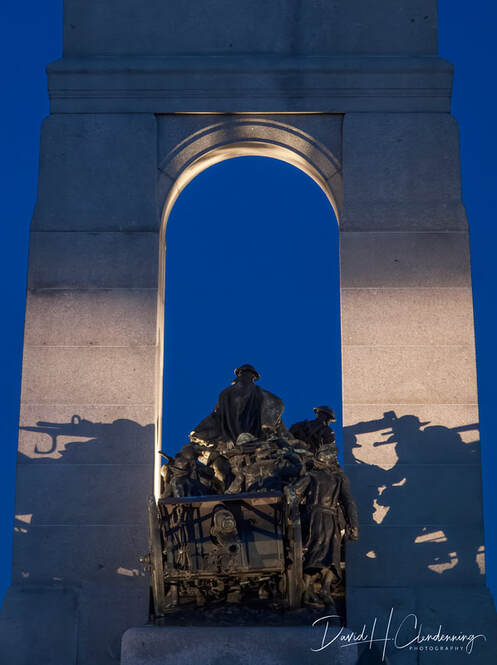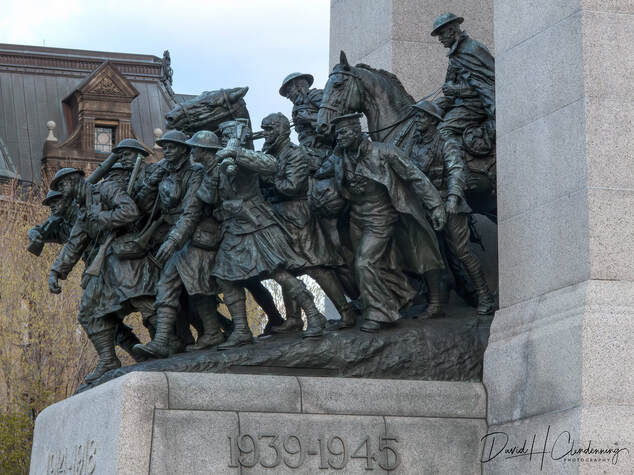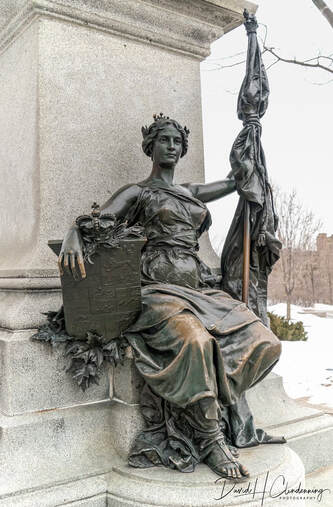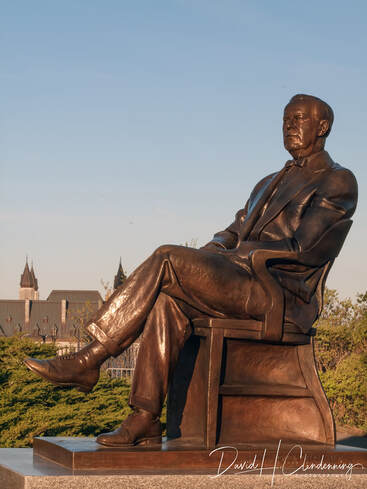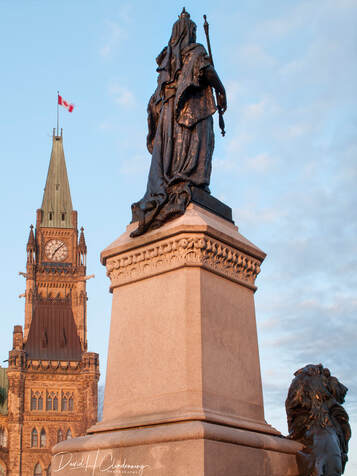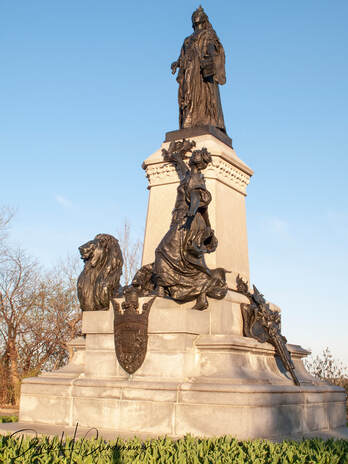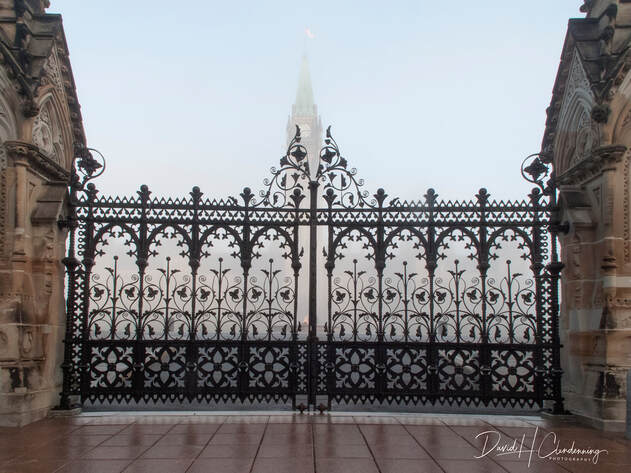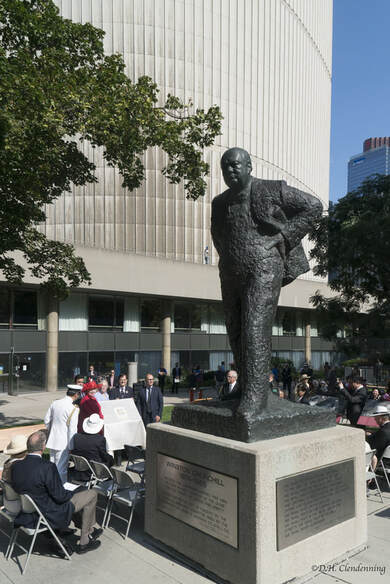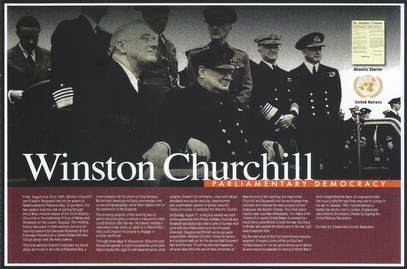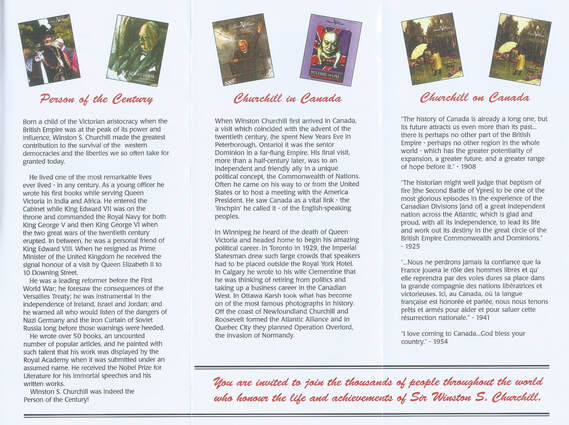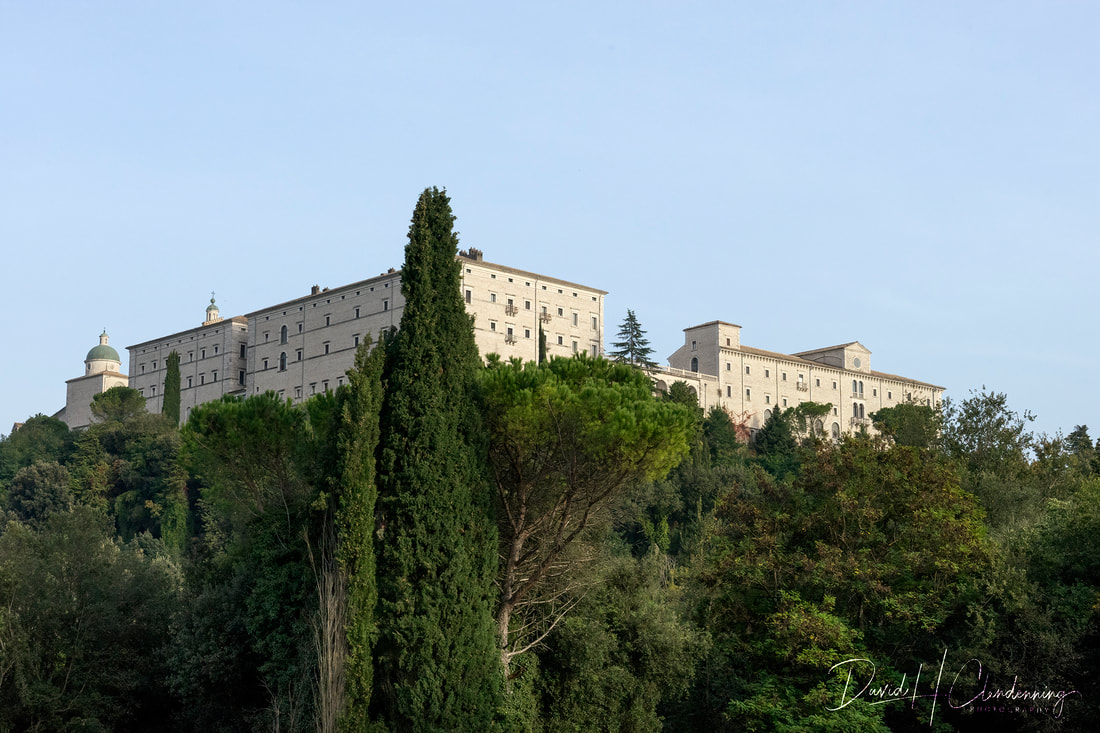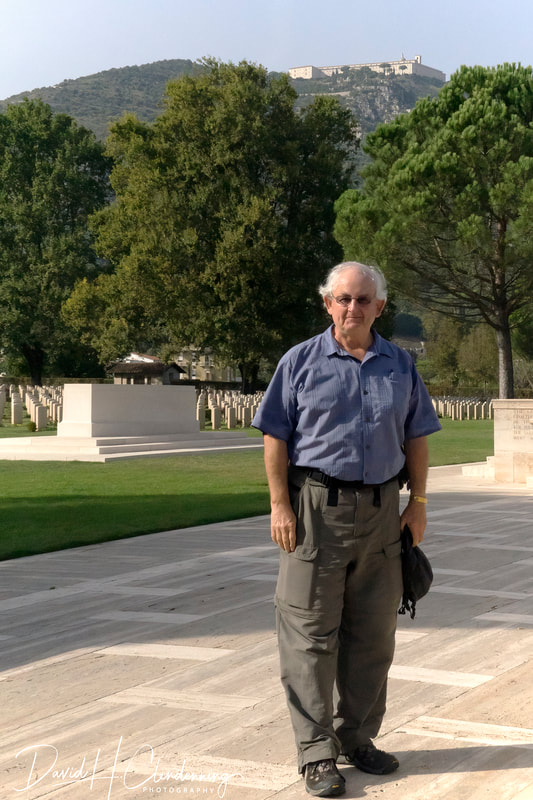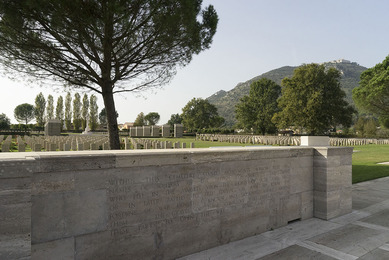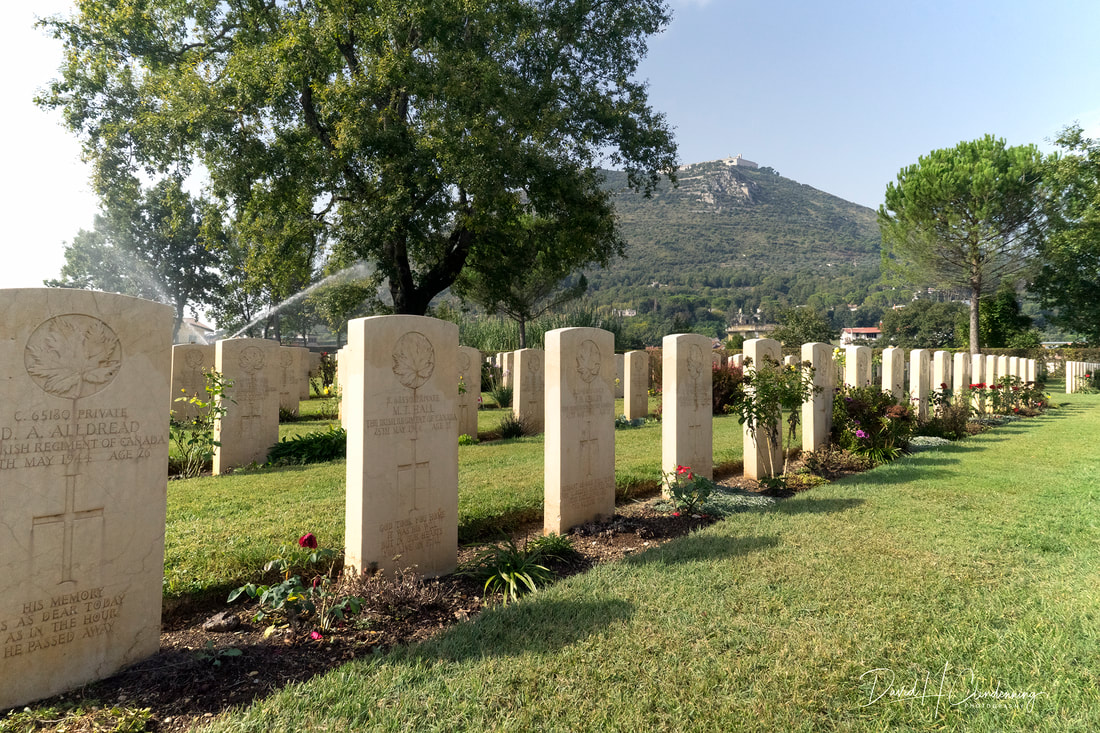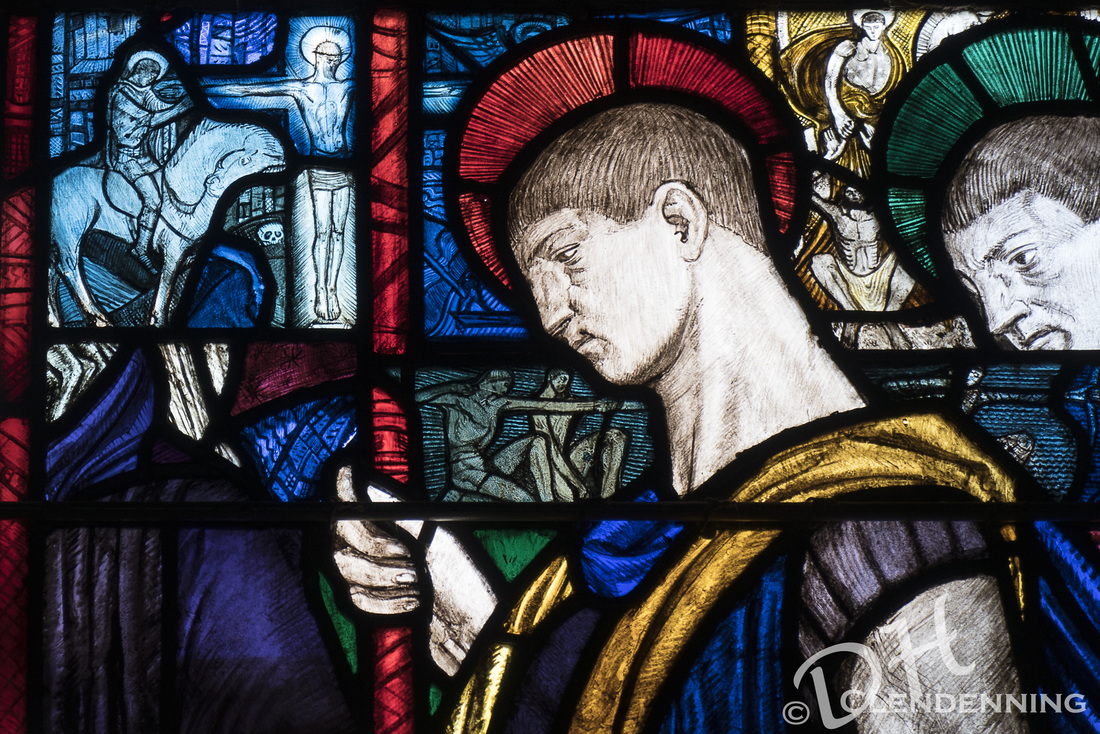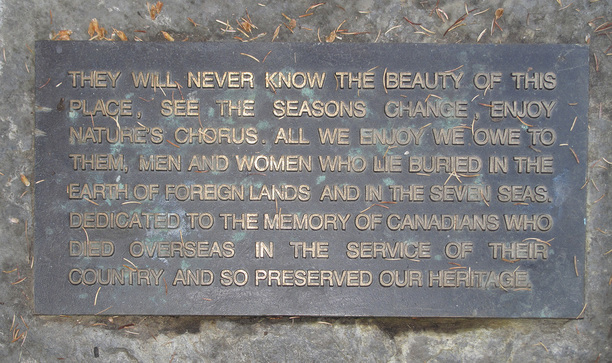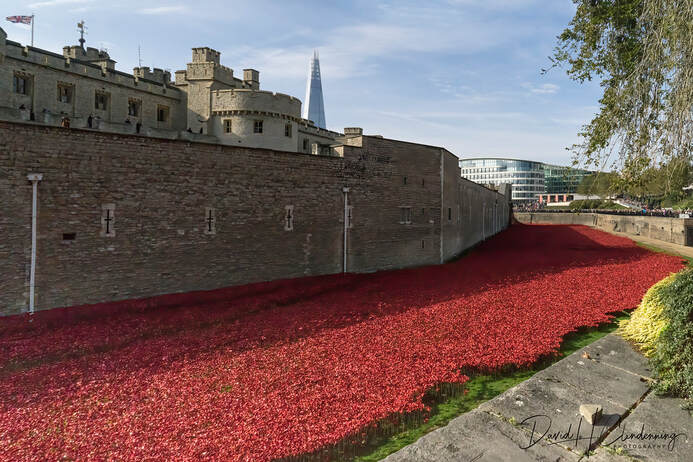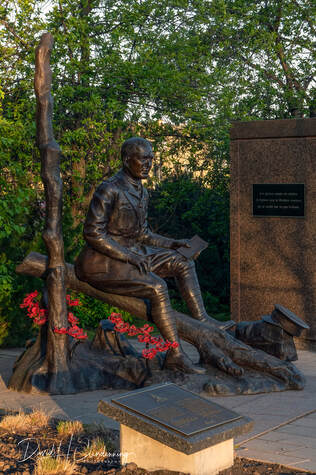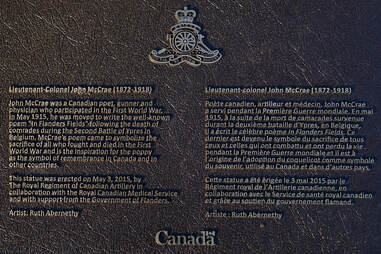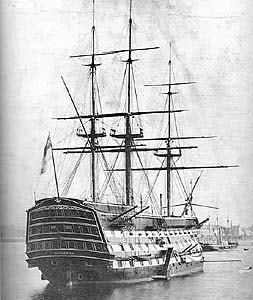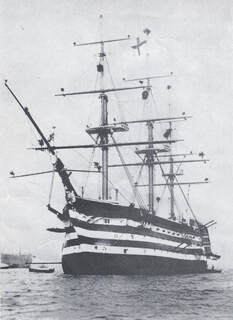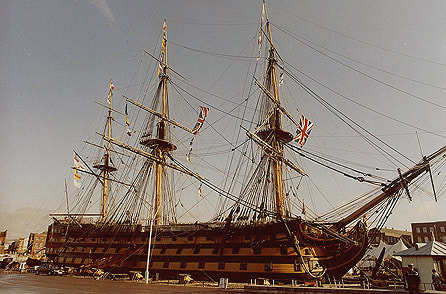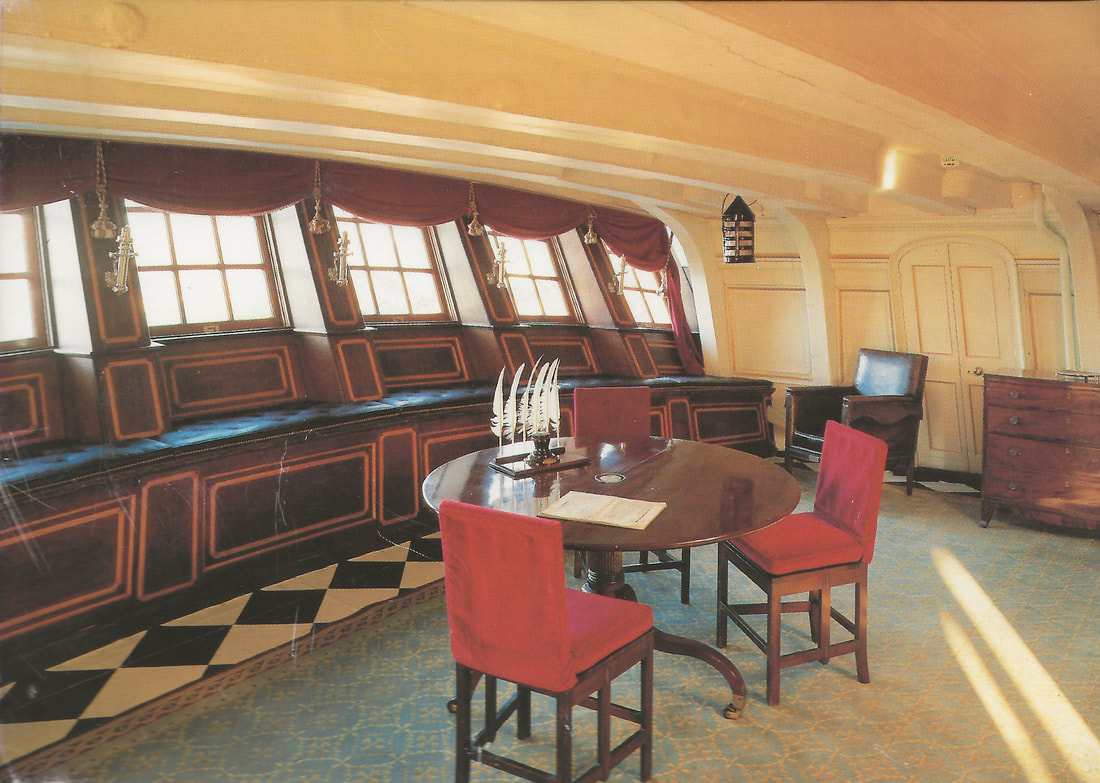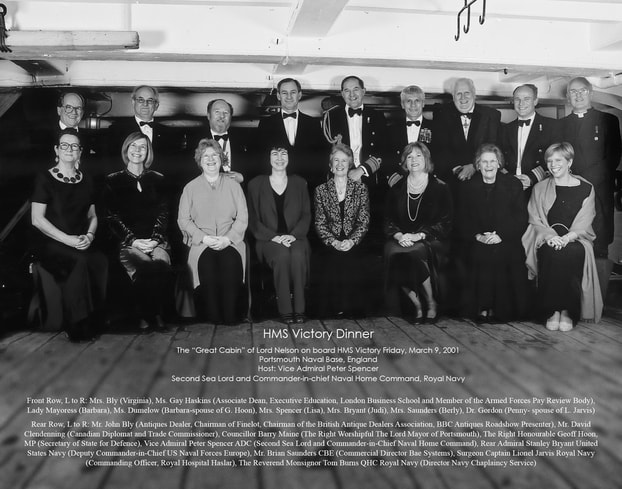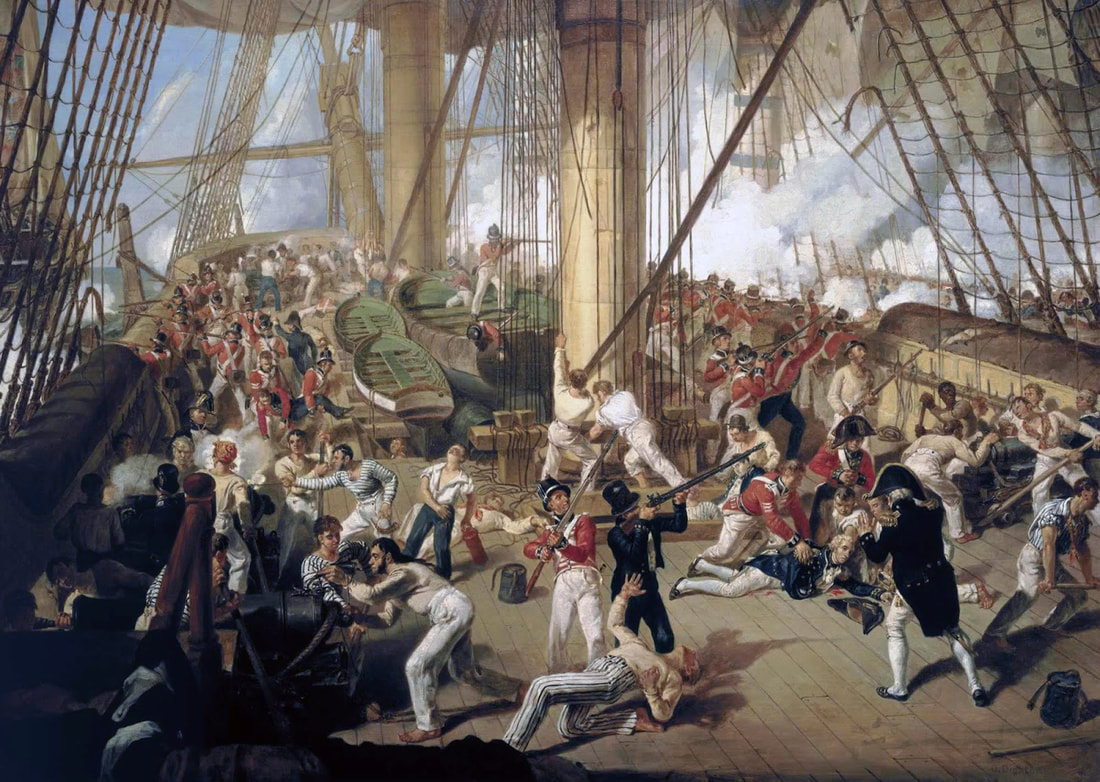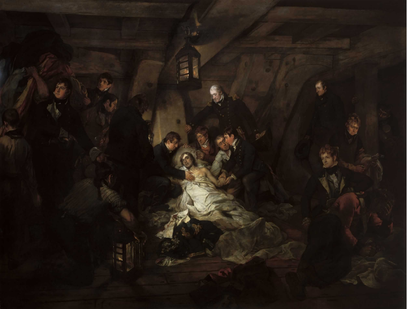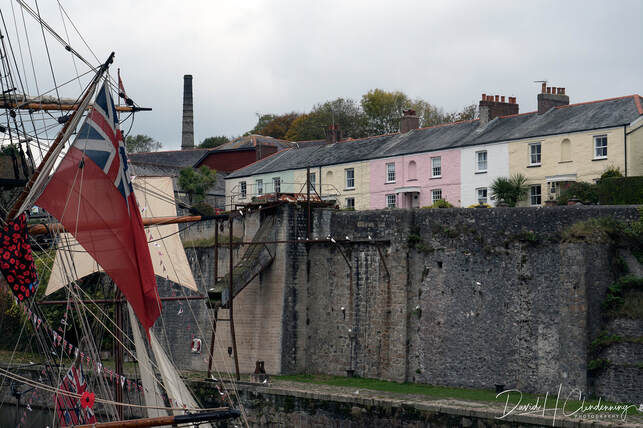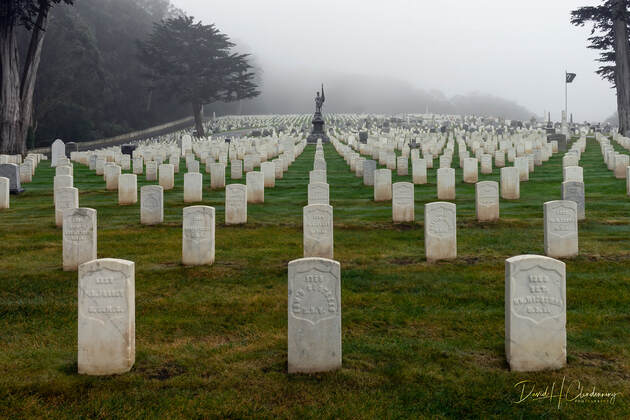Monuments |
The Supreme Sacrifice
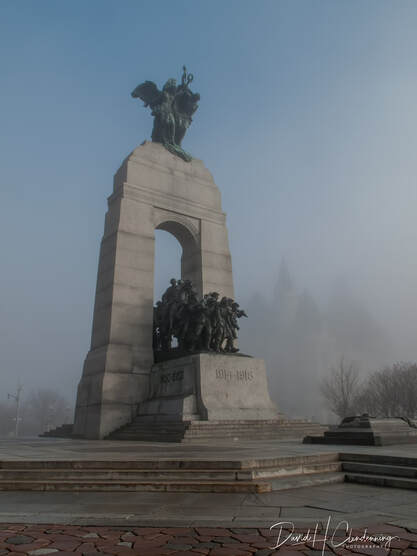 Title: Canadian War Memorial.
Location: Ottawa, Canada.
Order No.: A1-1198.
Title: Canadian War Memorial.
Location: Ottawa, Canada.
Order No.: A1-1198.
Canadian National War Memorial, Ottawa
The Great Response of Canada
In 1926, British sculpor Vernon March won the competition for Canada's First World War memorial in Ottawa. The sculpture to commemorate "The Response." of Canadians in the First World War, has, over the years, come to symbolize the sacrifice of all Canadians who have served Canada in time of war in the cause of peace and freedom. The dates 1939-1945 and 1950-1953 have been added in bronze numerals on each side of the memorial.
The Tomb of the Unknown Soldier was added to the base of the war memorial in May 2000.
Rising 21 metres from its base, the memorial consists of twenty-two larger-than-life bronze figures, including infantrymen, an airman, sailors, gunners, cavalrymen, a nursing sister and others advancing through an arch of granite bearing the allegorical figures of Peace and Freedom.
The allegorical figures of peace and freedom at the top to the monument are 5.33 metres in height. The figures are one-third greater than life size, each standing about 2.44 metres tall. In the faces of the marching figures there is character and purpose, sincerity and good intent. The figures are not shown in fighting attitudes, but rather express movement and the enthusiasm and eagerness of the people.
King George V1 unveiled the National War Monument in May 1939, just over three months before the outbreak of the Second World War.
The Great Response of Canada
In 1926, British sculpor Vernon March won the competition for Canada's First World War memorial in Ottawa. The sculpture to commemorate "The Response." of Canadians in the First World War, has, over the years, come to symbolize the sacrifice of all Canadians who have served Canada in time of war in the cause of peace and freedom. The dates 1939-1945 and 1950-1953 have been added in bronze numerals on each side of the memorial.
The Tomb of the Unknown Soldier was added to the base of the war memorial in May 2000.
Rising 21 metres from its base, the memorial consists of twenty-two larger-than-life bronze figures, including infantrymen, an airman, sailors, gunners, cavalrymen, a nursing sister and others advancing through an arch of granite bearing the allegorical figures of Peace and Freedom.
The allegorical figures of peace and freedom at the top to the monument are 5.33 metres in height. The figures are one-third greater than life size, each standing about 2.44 metres tall. In the faces of the marching figures there is character and purpose, sincerity and good intent. The figures are not shown in fighting attitudes, but rather express movement and the enthusiasm and eagerness of the people.
King George V1 unveiled the National War Monument in May 1939, just over three months before the outbreak of the Second World War.
Atlantic Charter Plaque Dedication Held at Toronto City Hall, Churchill Square in the presence of the Lieutenant Governor of Ontario, Her Honour, Elizabeth Dowdeswell, August 14, 2017
THE ATLANTIC CHARTER
The President of THE UNITED STATES OF AMERICA and the Prime Minister, Mr. Churchill, representing HIS MAJESTY'S GOVERNMENT IN THE UNTED KINGDOM, being met together, deem it right to make known certain common principles in the national policies of the respective countries on which they base their hopes for a better future for the world.
The President of THE UNITED STATES OF AMERICA and the Prime Minister, Mr. Churchill, representing HIS MAJESTY'S GOVERNMENT IN THE UNTED KINGDOM, being met together, deem it right to make known certain common principles in the national policies of the respective countries on which they base their hopes for a better future for the world.
|
|
|
1. Their countries seek no aggrandizement, territorial or other;
2. They deserve to see no territorial changes that do not accord with the freely expressed wishes of the peoples concerned;
3. They represent the right of all peoples to choose the form of government under which they will live; and they wish to see sovereign rights and self government restored to those who have been forcibly deprived of them;
4. They will endeavour, with due respect for their existing obligations, to further the enjoyment by all States, great or small, victor or vanquished, of access, on equal terms, to the trade and to the raw materials of the world which ae needed for their economic prosperity;
5. They desire to bring about the fullest collaboration between all nations in the economic field with the object of securing, for all, improved labor standards, economic advancement and social security in safety within their own boundaries, and which will afford assurance that all the men in all the lands may live out their lives in freedom from fear and want;
7. Such a peace should enable all men to traverse the high seas and oceans without hindrance;
8. They believe that all of the nations of the world, for realistic as well as spiritual reasons must come to the abandonment of these of force. Since no future peace can be maintained if land, sea or air armaments continue to be employed by nations which threaten, or may threaten, aggression outside of their frontiers, they believe, pending the establishment of a wider and permanent system of general security, that the disarmament of such nations is essential. They will likewise aid and encourage all other practicable measures which will lighten for peace-loving peoples the crushing burden of armaments.
August 14, 1941 FRANKLIN D. ROOSEVELT - WINSTON S. CHURCHILL
2. They deserve to see no territorial changes that do not accord with the freely expressed wishes of the peoples concerned;
3. They represent the right of all peoples to choose the form of government under which they will live; and they wish to see sovereign rights and self government restored to those who have been forcibly deprived of them;
4. They will endeavour, with due respect for their existing obligations, to further the enjoyment by all States, great or small, victor or vanquished, of access, on equal terms, to the trade and to the raw materials of the world which ae needed for their economic prosperity;
5. They desire to bring about the fullest collaboration between all nations in the economic field with the object of securing, for all, improved labor standards, economic advancement and social security in safety within their own boundaries, and which will afford assurance that all the men in all the lands may live out their lives in freedom from fear and want;
7. Such a peace should enable all men to traverse the high seas and oceans without hindrance;
8. They believe that all of the nations of the world, for realistic as well as spiritual reasons must come to the abandonment of these of force. Since no future peace can be maintained if land, sea or air armaments continue to be employed by nations which threaten, or may threaten, aggression outside of their frontiers, they believe, pending the establishment of a wider and permanent system of general security, that the disarmament of such nations is essential. They will likewise aid and encourage all other practicable measures which will lighten for peace-loving peoples the crushing burden of armaments.
August 14, 1941 FRANKLIN D. ROOSEVELT - WINSTON S. CHURCHILL
A NEW ATLANTIC CHARTER 2021
A new Atlantic Charter: Biden and Johnson agreed to a new Atlantic Charter modeled on the historic declaration made by President Franklin D. Roosevelt and Prime Minister Winston Churchill in 1941 that set out American and British goals for the world after the end of World War II, according to the White House and 10 Downing Street. The new Atlantic Charter that Biden and Johnson signed on June 10, 2021 is meant to reflect the shifting threats facing the world 80 years after the original document was signed
Sir Winston Churchill on Canada
Major Battles for Canada
First World War
The Great War 1914 - 1918
Go to: http://ww1.canada.com
The western front in the first world war and now - interactive
Go to: Guardian Newspaper, UK
Second World War
During WW11, 1,086,343 Canadian men and women enlist and 42,042 give up their lives in foreign fields, on the seas and in the air.
Italian Campaign
Over 63,000 Canadian soldiers took part in the Italian Campaign. There were 25,000 casualties of which 6,000 lost their lives. These soldiers are buried in 19 military cemeteries throughout Italy. The Italian campaign was by fare the largest and most costly campaign for the Canadian Forces during WW11. The Italian campaign began with the landing in Sicily on July 10, 1943.
Korean War
- Battles of Gravenstafel Ridge and St. Julien, April 23 to May 5, 1915. - Second Ypres Canadian Casualties: 6,064 wounded and killed.
- Vimy Ridge, April 9 to 12, 1917. - 10, 602 wounded and killed.
- Amiens, August 8 to 12, 1918. - 9,074 wounded and killed.
- Canal Du Nord and Cambrai, September 27 to October 11, 1918. - 13,672 wounded and killed.
The Great War 1914 - 1918
Go to: http://ww1.canada.com
The western front in the first world war and now - interactive
Go to: Guardian Newspaper, UK
Second World War
During WW11, 1,086,343 Canadian men and women enlist and 42,042 give up their lives in foreign fields, on the seas and in the air.
- Dieppe, August 19, 1941. - 1,413 wounded and killed, 1,946 captured.
- Assoro, July 20 to 22, 1943.
- Juno Beach, June 6, 1944. - 1,200 wounded and killed
- Breskens Pocket, October 6 to November 3, 1944. - 600 wounded and killed.
- Groningen, April 14 to 18, 1945. - 209 wounded and killed.
Italian Campaign
Over 63,000 Canadian soldiers took part in the Italian Campaign. There were 25,000 casualties of which 6,000 lost their lives. These soldiers are buried in 19 military cemeteries throughout Italy. The Italian campaign was by fare the largest and most costly campaign for the Canadian Forces during WW11. The Italian campaign began with the landing in Sicily on July 10, 1943.
Korean War
- Kap Yong, April 22 to 25, 1951. - 33 wounded and killed.
14 Infantry Brigade Dinner, Fort York Armoury, Toronto - 1936
Officers in Attendance:
Toronto Regiment, Queen's Rangers - 1st American Regiment, Toronto Scottish Regiment, Irish Regiment of Canada
Toronto Regiment, Queen's Rangers - 1st American Regiment, Toronto Scottish Regiment, Irish Regiment of Canada
Cassino War Cemetery and Memorial, Italy
Between January and May 1944, this region saw fierce fighting as the Allies attempted to break though the formidable Gustav Line by driving German forces from the town of Cassino and the heights which surround it. The Allies lost over 50,000 men killed and wounded at Cassino.
The capture of Monte Cassino opened the route to Rome, but German resistance would continue further north along the Gothic Line.
The Cassino War Cemetery is the final resting place to nearly 4,300 Commonweath serviceman who fought in Sicily and Italy.
The capture of Monte Cassino opened the route to Rome, but German resistance would continue further north along the Gothic Line.
The Cassino War Cemetery is the final resting place to nearly 4,300 Commonweath serviceman who fought in Sicily and Italy.
Peace and Remembrance
Glass Heritage in Canada
Memorial Plaque in the Canadian Rockies
United Kingdom
Art Installation - Tower of London Poppy Garden
Some five million people visited the 'Blood Swept Lands And Seas of Red installation planted to honour every British or Commonwealth citizen who died during World War One.
Blood Red Field of Poppies.
The first of the 888, 246 ceramic poppies was planted in the Tower's dry moat in July, with the final one installed by Armistice Day, November 11, 2014. The poppy garden was dismantled shortly after the remembrance day ceremony.
Queen's Christmas Broadcast 2014
" Reconciliation is the peaceful end to conflict, and we were reminded of this in August when countries on both sides of the First World War came together to remember in peace. The ceramic poppies at the Tower of London drew millions, and the only possible reaction to seeing them and walking among them was silence. For every poppy a life; and a reminder of the grief of loved ones left behind."
- Her Majesty, Queen Elizabeth 11
Blood Red Field of Poppies.
The first of the 888, 246 ceramic poppies was planted in the Tower's dry moat in July, with the final one installed by Armistice Day, November 11, 2014. The poppy garden was dismantled shortly after the remembrance day ceremony.
Queen's Christmas Broadcast 2014
" Reconciliation is the peaceful end to conflict, and we were reminded of this in August when countries on both sides of the First World War came together to remember in peace. The ceramic poppies at the Tower of London drew millions, and the only possible reaction to seeing them and walking among them was silence. For every poppy a life; and a reminder of the grief of loved ones left behind."
- Her Majesty, Queen Elizabeth 11
Canada - John McCrae Memorial
John McCrae, the First World War Canadian army doctor wrote the poem, "In Flanders Fields", that a hundred years later, continues to stir the hearts of people around the world.
HMS Victory Dock, Portsmouth, England - National Historic Site
HMS Victory
In December 1758, the Board of the Admiralty in London gave orders that twelve battle ships to include one ‘first rate’ with 100 guns, were to be built. It was in 1759 before she was named “Victory” and she was not launched until 1765 due to the British successes of the Seven Year’s War with France and Spain.
She was completed and prepared for active service in 1778 when the War of American Independence broke out.
“Victory” was designed by the senior surveyor of the Navy, Thomas Slade, and was built at Chatham Dockyard, Kent, under the supervision of Master Shipwright, Edward Allen.
Around 6000 trees were used in her construction (equivalent to about 100 acres of forest), of which 90% were oak (mainly from Kent, the New Forest and Germany) and the remainder elm, pine and fir, together with a small quantity of Lignum Vitae.
Lower masts made of several trees were bound together with iron hoops, and over 2 tons of iron and copper nails and bolts were used hold the beams and joints, all this basically held the whole ship together. Her final coast was 63, 176 pounds (present day cost around 50 million pounds).
Fighting ships of this era were divided into six ‘rates’ according to the number of guns and the size of her crews. The ‘first rates’ were the most powerful, with over 100 guns and more than 800 officers and men.
A major refit of “Victory” took place in 1803, which also changed her outward appearance, and she remained in constant service between 1778 and 1812. The peak of her career came when she was Nelson’s flagship in the Mediterranean from 1803 until the Battle of Trafalgar on 21 October 1805.
It was on the day of this battle that Nelson sent his famous signal, ‘England expects that every man will do his duty’.
The crew of “Victory” had been well-trained in gunnery and they could therefore maintain a far more deadly rate of fire than their opponents although during the battle they became entangled with a French ship whose men had received special training in small arms.
It was here on the Quarterdeck that Nelson was shot by a stray bullet, which killed him some hours later. He lived long enough to find out that victory had been achieved.
In 1922, “Victory” was moved to Portsmouth’s Royal Naval Dockyard, and preserved as a museum ship where continuous research and repairs are underway. She has been the flagship of the First Sea Lord since October 2012 and is the world’s oldest naval ship still in commission.
From Polperro Heritage Museum, Cornwall, UK; The Historic Dockyard Chatham (Tudor to 20th century) – Historic Royal Navy warships and shipbuilding heritage in an 18th –century dockyard museum.
In December 1758, the Board of the Admiralty in London gave orders that twelve battle ships to include one ‘first rate’ with 100 guns, were to be built. It was in 1759 before she was named “Victory” and she was not launched until 1765 due to the British successes of the Seven Year’s War with France and Spain.
She was completed and prepared for active service in 1778 when the War of American Independence broke out.
“Victory” was designed by the senior surveyor of the Navy, Thomas Slade, and was built at Chatham Dockyard, Kent, under the supervision of Master Shipwright, Edward Allen.
Around 6000 trees were used in her construction (equivalent to about 100 acres of forest), of which 90% were oak (mainly from Kent, the New Forest and Germany) and the remainder elm, pine and fir, together with a small quantity of Lignum Vitae.
Lower masts made of several trees were bound together with iron hoops, and over 2 tons of iron and copper nails and bolts were used hold the beams and joints, all this basically held the whole ship together. Her final coast was 63, 176 pounds (present day cost around 50 million pounds).
Fighting ships of this era were divided into six ‘rates’ according to the number of guns and the size of her crews. The ‘first rates’ were the most powerful, with over 100 guns and more than 800 officers and men.
A major refit of “Victory” took place in 1803, which also changed her outward appearance, and she remained in constant service between 1778 and 1812. The peak of her career came when she was Nelson’s flagship in the Mediterranean from 1803 until the Battle of Trafalgar on 21 October 1805.
It was on the day of this battle that Nelson sent his famous signal, ‘England expects that every man will do his duty’.
The crew of “Victory” had been well-trained in gunnery and they could therefore maintain a far more deadly rate of fire than their opponents although during the battle they became entangled with a French ship whose men had received special training in small arms.
It was here on the Quarterdeck that Nelson was shot by a stray bullet, which killed him some hours later. He lived long enough to find out that victory had been achieved.
In 1922, “Victory” was moved to Portsmouth’s Royal Naval Dockyard, and preserved as a museum ship where continuous research and repairs are underway. She has been the flagship of the First Sea Lord since October 2012 and is the world’s oldest naval ship still in commission.
From Polperro Heritage Museum, Cornwall, UK; The Historic Dockyard Chatham (Tudor to 20th century) – Historic Royal Navy warships and shipbuilding heritage in an 18th –century dockyard museum.
HMS Victory Dinner - 2001
Battle of Trafalgar on 21 October 1805
HMS Victory was to be Nelson's flagship as a commander-in-chief of the Mediterranean Fleet, locked in conflict with the navy of France now led by Emperor Nepolean. By 1904, the French were trying to destroy the Royal Navy, or at least entice it away from the English Channel to give an invasion force a clear run at Britain. But Admiral Villeneuve's Franco-Spanish fleet was trapped at Toulon. Breaking out eventually, it was pursued south to Cadiz, in Spain, by Nelson, who finally confronted it near to Cape Trafalgar.
Breaking the rules for the final time, Nelson formed his fleet into smaller squadrons in order to outmaneuver Villeneuve's traditional line formation. He had the signal flags spell out the message "England expects every man to do his duty." He was no exception, walking openly on the deck throughout, an inspirational presence to his men - and an irresistible target for the French sniper who finally felled him with a shot. His hero's death, in the hour of victory, became emblematic of the British spirit of self-sacrifice. His body, having been taken home, was borne up the River Thames on a barge and he was given a splendid state funeral at St. Paul's Cathedral.
HMS Victory was to be Nelson's flagship as a commander-in-chief of the Mediterranean Fleet, locked in conflict with the navy of France now led by Emperor Nepolean. By 1904, the French were trying to destroy the Royal Navy, or at least entice it away from the English Channel to give an invasion force a clear run at Britain. But Admiral Villeneuve's Franco-Spanish fleet was trapped at Toulon. Breaking out eventually, it was pursued south to Cadiz, in Spain, by Nelson, who finally confronted it near to Cape Trafalgar.
Breaking the rules for the final time, Nelson formed his fleet into smaller squadrons in order to outmaneuver Villeneuve's traditional line formation. He had the signal flags spell out the message "England expects every man to do his duty." He was no exception, walking openly on the deck throughout, an inspirational presence to his men - and an irresistible target for the French sniper who finally felled him with a shot. His hero's death, in the hour of victory, became emblematic of the British spirit of self-sacrifice. His body, having been taken home, was borne up the River Thames on a barge and he was given a splendid state funeral at St. Paul's Cathedral.
78 Paintings that Follow Nelson's actions at the Battle of Trafalgar, 21 October 1805. With Footnotes
Go to: myartblogcollection.blogspot.com/2016/09/78-paintings-battle-of-trafalgar-21.html
Go to: myartblogcollection.blogspot.com/2016/09/78-paintings-battle-of-trafalgar-21.html
Armistice Day in an historic Cornwall Fishing Village - 2016
United States
US National Cemetery, Presideo of San Francisco
On December 12, 1884, the US War Department designated 9 acres (3.6 ha), including the site of the old post cemetery, as San Francisco National Cemetery. It was the first national cemetery established on the West Coast and marks the growth and development of a system of national cemeteries extending beyond the battlefields of the Civil War.
There are also three British Commonwealth service war graves here, a Canadian soldier of World War I, and a Royal Navy and Merchant Navy sailor of World War II.
The cemetery is enclosed with a stone wall and slopes down a hill that today frames a view of the Golden Gate Bridge.
On December 12, 1884, the US War Department designated 9 acres (3.6 ha), including the site of the old post cemetery, as San Francisco National Cemetery. It was the first national cemetery established on the West Coast and marks the growth and development of a system of national cemeteries extending beyond the battlefields of the Civil War.
There are also three British Commonwealth service war graves here, a Canadian soldier of World War I, and a Royal Navy and Merchant Navy sailor of World War II.
The cemetery is enclosed with a stone wall and slopes down a hill that today frames a view of the Golden Gate Bridge.
